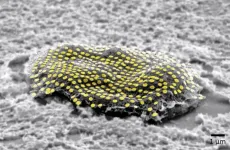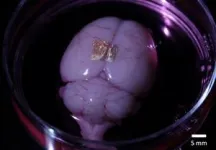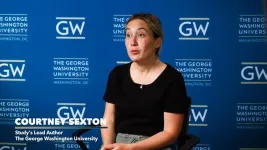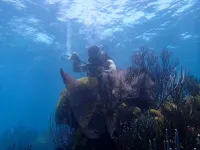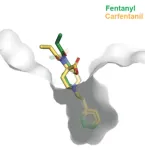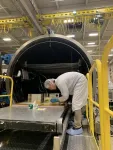(Press-News.org) Engineers have developed nanoscale tattoos—dots and wires that adhere to live cells—in a breakthrough that puts researchers one step closer to tracking the health of individual cells.
The new technology allows for the first time the placement of optical elements or electronics on live cells with tattoo-like arrays that stick on cells while flexing and conforming to the cells’wet and fluid outer structure.
“If you imagine where this is all going in the future, we would like to have sensors to remotely monitor and control the state of individual cells and the environment surrounding those cells in real time,” said David Gracias, a professor of chemical and biomolecular engineering at Johns Hopkins University who led the development of the technology. “If we had technologies to track the health of isolated cells, we could maybe diagnose and treat diseases much earlier and not wait until the entire organ is damaged.”
The details are published in Nano Letters.
Gracias, who works on developing biosensor technologies that are nontoxic and noninvasive for the body, said the tattoos bridge the gap between living cells or tissue and conventional sensors and electronic materials. They’re essentially like barcodes or QR codes, he said.
“We're talking about putting something like an electronic tattoo on a living object tens of times smaller than the head of a pin,” Gracias said. “It’s the first step towards attaching sensors and electronics on live cells.”
The structures were able to stick to soft cells for 16 hours even as the cells moved.
The researchers built the tattoos in the form of arrays with gold, a material known for its ability to prevent signal loss or distortion in electronic wiring. They attached the arrays to cells that make and sustain tissue in the human body, called fibroblasts. The arrays were then treated with molecular glues and transferred onto the cells using an alginate hydrogel film, a gel-like laminate that can be dissolved after the gold adheres to the cell. The molecular glue on the array bonds to a film secreted by the cells called the extracellular matrix.
Previous research has demonstrated how to use hydrogels to stick nanotechnology onto human skin and internal animal organs. By showing how to adhere nanowires and nanodots onto single cells, Gracias’ team is addressing the long-standing challenge of making optical sensors and electronics compatible with biological matter at the single cell level.
“We’ve shown we can attach complex nanopatterns to living cells, while ensuring that the cell doesn’t die,” Gracias said. “It’s a very important result that the cells can live and move with the tattoos because there’s often a significant incompatibility between living cells and the methods engineers use to fabricate electronics.”
The team’s ability to attach the dots and wires in an array form is also crucial. To use this technology to track bioinformation, researchers must be able to arrange sensors and wiring into specific patterns not unlike how they are arranged in electronic chips.
“This is an array with specific spacing,” Gracias explained, “not a haphazard bunch of dots.”
The team plans to try to attach more complex nanocircuits that can stay in place for longer periods. They also want to experiment with different types of cells.
Other Johns Hopkins authors are Kam Sang Kwok, Yi Zuo, Soo Jin Choi, Gayatri J. Pahapale, and Luo Gu.
END
Latest in body art? ‘Tattoos’ for individual cells
New technology could provide early warnings for health problems
2023-08-07
ELSE PRESS RELEASES FROM THIS DATE:
Georgia State Researcher awarded $3.6 million grant to help address mental health crisis in schools
2023-08-07
ATLANTA — Catherine Perkins, a clinical professor in the College of Education & Human Development at Georgia State University, has been awarded a five-year, $3.6 million grant by the U.S. Department of Education to expand quality school-based mental health (SBMH) services for underserved populations in high-need schools.
The Expanding Quality SBMH Services for Underserved Populations with Inclusive Practices (GSU-EQUIP) grant will have a direct impact in metro Atlanta by increasing access to school-based programs and strengthening the candidate pool of mental ...
Current estimates of Lake Erie algae toxicity may miss the mark
2023-08-07
COLUMBUS, Ohio – There is more to a harmful algal bloom than the green stuff in water that meets the eye – specifically, a changing hazard level of toxins produced by the microbes that make up the scummy mess.
A new study analyzing toxins produced by Microcystis, the main type of cyanobacteria that compose the annual harmful algal bloom (HAB) in Lake Erie, suggests that the toxicity of the bloom may be overestimated in earlier warm months and underestimated later in the summer.
The research is part of a large project, led by The Ohio State University, designed to develop a more accurate harmful algal bloom toxicity forecast ...
Dogs with less complex facial markings found to be more expressive in their communication with humans
2023-08-07
WASHINGTON (August 7, 2023) – The domestication of canines and their co-evolution with humans has fostered an incredibly unique relationship with these animals. Over time, our four-legged friends have adapted well to understanding human modes of communication, both verbal and nonverbal. However, researchers at the George Washington University say humans could do more to better understand our furry companions, and a dogs’ facial markings may be one key to meeting them halfway.
In a new paper published in the journal Animals, ...
Century-old coral reveals Pacific western boundary current strengthened as climate warmed, impacting El Niño
2023-08-07
Chestnut Hill, Mass. (8/7/2023) - The Pacific Ocean’s western boundary current, which forms a critical regulator of sea surface temperature and weather patterns, has significantly strengthened as the planet warms, according to a new study published in the journal Nature Geoscience.
The study provides the first evidence that the western boundary current in the South Pacific has significantly strengthened during the 20th century in response to global warming, contributing to an intensified equatorial undercurrent, according to Boston College Assistant Professor of Earth and Environmental Sciences Xingchen (Tony) Wang, a co-author ...
For Black teens, school belonging can be a matter of life and death
2023-08-07
Academic performance has long been linked to how supported students feel at school. Now, a Rutgers study suggests this sentiment is also essential to preventing suicides.
A Rutgers researcher found that having a strong sense of school belonging – the subjective feeling of being accepted, valued, included and encouraged in the school community – could mitigate suicidal tendencies among Black adolescents.
“Having a supportive teacher or other nonparent adult can change a child’s life because they will want to go to school,” said Adrian Gale, an assistant professor at the Rutgers School of Social Work and co-author of the study ...
Human antibody that targets carfentanil, fentanyl and related opioids reverses overdose effects in preclinical study
2023-08-07
LA JOLLA, CA—An antibody in single-chain fragment variable (scFv) format that binds to the powerful opioid carfentanil was shown to reverse signs of carfentanil overdose in preclinical tests conducted by scientists at Scripps Research.
Carfentanil is a variant of the synthetic opioid fentanyl, and about 100 times as potent as its chemical cousin. Along with fentanyl and other fentanyl variants, it is commonly mixed with illegal drugs such as heroin and cocaine to enhance their euphoric effects, resulting in many fatal overdoses.
In the study, published in ACS ...
Midwest Integrated Center for Computational Materials renewed by U.S. Department of Energy
2023-08-07
The U.S. Department of Energy (DOE) has announced the renewal of the Midwest Integrated Center for Computational Materials (MICCoM) for another three years at $3 million per year. Founded in 2015, the Center is headquartered at DOE’s Argonne National Laboratory. Partnering universities include the University of Chicago, University of Notre Dame and University of California, Davis.
“The MICCoM team has been at the forefront of developing simulation methods and codes and solving cutting-edge materials science problems,” said Center director Giulia Galli. She is also a senior scientist in Argonne’s Materials Science division and professor in the ...
New blood-pressure related measure predicts health outcomes in patients with intensive care
2023-08-07
Key Takeaways
A new method derived from standard blood pressure assessments can improve monitoring of critically ill patients with circulatory shock
The method accurately predicts risk of death, length of hospital stay, and blood lactate levels (an indicator of tissue perfusion and oxygenation).
BOSTON – Critically ill patients with circulatory shock—when the heart cannot pump enough blood and oxygen to the rest of the body, often as a result of heart failure, sepsis, or hemorrhage—require close monitoring and treatment, especially to maintain adequate blood pressure to prevent injury to important organs. ...
Building bacteria: researchers use cyanobacteria to ‘grow’ stronger sand-based construction materials
2023-08-07
Researchers have successfully grown bacterial cells in potential sand-based construction materials, as detailed in a paper published by Research Directions: Biotechnology Design, a new journal from Cambridge University Press.
This achievement marks a substantial contribution to the field of biodesign, which seeks to incorporate living organisms into building materials as a means of making architecture more sustainable. It is effectively a fusion of biological and architectural expertise, with the shared goal of building better.
Cyanobacteria could enable the solidification of inorganic materials such as CO2, ...
NRL and NASA to launch ComPair instrument to measure gamma-ray emissions
2023-08-07
WASHINGTON – The U.S. Naval Research Laboratory (NRL) and NASA Goddard Space Flight Center (GSFC) will launch ComPair aboard a high-altitude balloon from Fort. Sumner, New Mexico Aug. 10.
The ComPair mission instrument measures and detects gamma-ray emissions from astrophysical objects. The NRL instrument is one of the four subsystem instruments led by NASA GSFC. The mission name – ComPair – is inspired by the mechanisms by which gamma rays interact with matter.
“They do so via three dominant processes – photoelectric effect, ...
LAST 30 PRESS RELEASES:
Uterine fibroids linked to elevated heart disease risk
Dual use of cigarettes and vapes can reduce risks of smoking and help smokers quit
New bioelectronics device based on hydrogel- elastomer conductive nanomembranes
More yield through heterosis: IPK research team decodes gene interaction
James Webb telescope reveals spectacular atmospheric escape
ICE-CSIC leads a pioneering study on the feasibility of asteroid mining
Dramatic rise in young people using mental health services
Be careful trusting TikTok for gout advice
A study by the University of Seville links the vanishing of the specific heats at absolute zero with the principle of entropy increase
Anxiety and insomnia may lower natural killer cell count, potentially repressing immune function
How parasitic, asexual plants evolve and live
Research spotlight: A subset of patients with depression could benefit from anti-inflammatory treatment
New fully digital design paves the way for scalable probabilistic computing
Membrane electrode assembly design for high-efficiency anion exchange membrane water electrolysis
U.S. debt ceiling disputes show measurable impact on global crude oil markets
Climate extremes triggered rare coral disease and mass mortality on the Great Barrier Reef
Direct observation reveals “two-in-one” roles of plasma turbulence
Humans rank between meerkats and beavers in monogamy ‘league table’
US fossil reveals early mass-burial event and ancient microbial attack
Sedative choice could improve outcomes for breathing tube patients
New superconducting thin film for quantum computer chips
Simulations reveal protein "dynamin" constricts cell membranes by loosening its grip
Nearly 1 in 5 UK emergency department patients cared for in corridors/waiting rooms
Heavy energy drink intake may pose serious stroke risk, doctors warn
Violence against women and children among top health threats: New global study reveals disease burden far larger than previously estimated
Predicting who is at risk of developing type 1 diabetes, as new drugs now available
New gene-mapping method unlocks hidden drivers of cancer
Ocean current and seabed shape influence warm water circulation under ice shelves
Call to increase funding for ‘invisible’ Deaf victim-survivors of domestic abuse
University of Maryland School of Medicine names distinguished scientist and academic leader Gerald M. Wilson, PhD, as Chair of the Department of Biochemistry and Molecular Biology
[Press-News.org] Latest in body art? ‘Tattoos’ for individual cellsNew technology could provide early warnings for health problems
